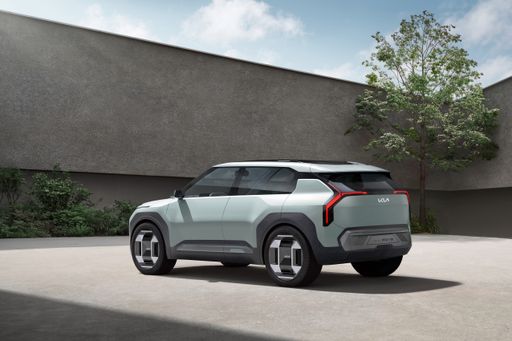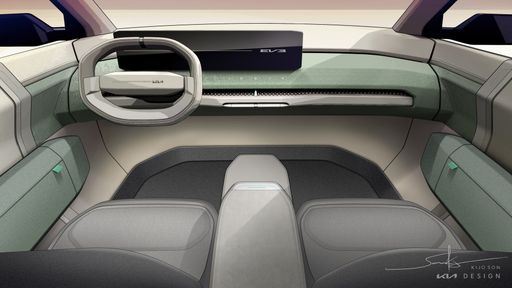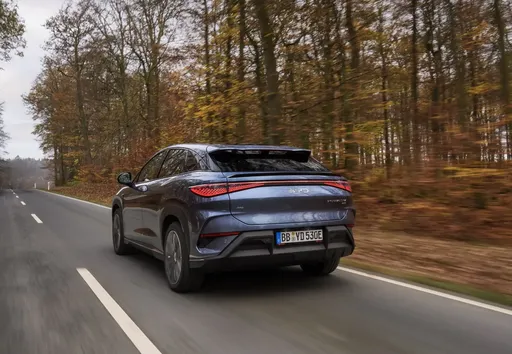As the electric vehicle market continues to expand, two noteworthy contenders have entered the ring: the Kia EV3 and the BYD Sealion 7. Both vehicles offer unique features and impressive specifications that cater to different consumer preferences. In this comparison, we will explore the technical aspects, innovations, and overall appeal of each model.
Kia EV3 vs BYD Sealion 7 – Which car suits you better?
Two cars, one duel: Kia EV3 meets BYD Sealion 7.
Which one wins in performance, efficiency and value for money? Find out now!
Power and Performance
The Kia EV3 is equipped with a single electric motor that produces up to 204 horsepower (150 kW) and 283 Nm of torque. This enables the EV3 to accelerate from 0 to 100 km/h in approximately 7.5 to 7.9 seconds, depending on the variant. With a top speed of 170 km/h and an electric range of up to 605 km, it is an ideal choice for city dwellers and those who enjoy weekend getaways.
On the other hand, the BYD Sealion 7 offers significantly more power, boasting a dual-motor setup that provides an exhilarating 530 horsepower (390 kW) and up to 690 Nm of torque. This allows the Sealion 7 to dash from 0 to 100 km/h in a breathtaking 4.5 seconds. With a maximum speed of 215 km/h and an electric range of up to 502 km, this SUV targets a performance-focused audience.
Efficiency and Battery Technology
Efficiency is a cornerstone of electric vehicle development, and both the Kia EV3 and BYD Sealion 7 showcase impressive metrics. The EV3 has a consumption range of 14.9 to 16.2 kWh/100 km, making it an economical option for daily commuting. It comes with two battery options: a 58.3 kWh and an 81.4 kWh pack, enabling drivers to select according to their range requirements.
The BYD Sealion 7, while slightly less efficient with a consumption rate of 19.9 to 21.9 kWh/100 km, compensates by offering advanced battery technology. Its larger battery capacity supports longer battery lifespan and quicker charging, crucial for an electric vehicle's usability in everyday life.
Design and Interior Space
In terms of design, the Kia EV3 sports a sleek and modern SUV silhouette with five doors. Its compact length of 4300-4310 mm and a width of 1850 mm make it agile in urban environments. The trunk capacity of 460 liters provides ample storage space for shopping trips or weekend excursions.
The BYD Sealion 7 has a more substantial footprint, measuring 4830 mm in length and 1925 mm in width, which contributes to its robust appearance. With a trunk capacity of 520 liters, it trumps the EV3 in terms of utility, catering to those who prioritize space in their vehicles.
Seating and Comfort Features
Both vehicles comfortably seat five passengers, offering a spacious interior, but the variation in dimensions may lead to differing passenger experiences. The EV3’s interior is designed with a focus on modern aesthetics, intuitive controls, and a clean layout. Connectivity features include a touchscreen infotainment system and compatibility with smartphone integration.
In contrast, the BYD Sealion 7 places a strong emphasis on luxury. It features high-quality materials throughout the cabin, advanced comfort features, and extensive technology integration for a premium driving experience.
Conclusion: Which One Is Right for You?
Choosing between the Kia EV3 and BYD Sealion 7 comes down to personal preferences and driving needs. If you are looking for a compact, efficient electric SUV with a solid range, the Kia EV3 is an excellent choice. However, if performance, luxury, and spaciousness are your top priorities, the BYD Sealion 7 stands out with its impressive specs and features.
Ultimately, both vehicles represent significant advancements in the electric vehicle landscape, making them worthy contenders in today’s market. Whether you prefer the approachable practicality of the Kia or the high-performance allure of the BYD, both models highlight the exciting future of electric mobility.
Here’s where it gets real: The technical differences in detail
Costs and Efficiency:
Looking at overall running costs, both models reveal some interesting differences in everyday economy.
Kia EV3 has a clearly perceptible advantage in terms of price – it starts at 30800 £, while the BYD Sealion 7 costs 42800 £. That’s a price difference of around 12000 £.
In terms of energy consumption, the advantage goes to the Kia EV3: with 14.90 kWh per 100 km, it’s clearly perceptible more efficient than the BYD Sealion 7 with 19.90 kWh. That’s a difference of about 5 kWh.
As for range, the Kia EV3 performs slightly better – achieving up to 605 km, about 103 km more than the BYD Sealion 7.
Engine and Performance:
Power, torque and acceleration say a lot about how a car feels on the road. This is where you see which model delivers more driving dynamics.
When it comes to engine power, the BYD Sealion 7 has a convincingly edge – offering 530 HP compared to 204 HP. That’s roughly 326 HP more horsepower.
In acceleration from 0 to 100 km/h, the BYD Sealion 7 is significantly quicker – completing the sprint in 4.50 s, while the Kia EV3 takes 7.50 s. That’s about 3 s faster.
In terms of top speed, the BYD Sealion 7 performs evident better – reaching 215 km/h, while the Kia EV3 tops out at 170 km/h. The difference is around 45 km/h.
There’s also a difference in torque: BYD Sealion 7 pulls convincingly stronger with 690 Nm compared to 283 Nm. That’s about 407 Nm difference.
Space and Everyday Use:
Whether family car or daily driver – which one offers more room, flexibility and comfort?
Both vehicles offer seating for 5 people.
In curb weight, Kia EV3 is distinct lighter – 1800 kg compared to 2225 kg. The difference is around 425 kg.
In terms of boot space, the BYD Sealion 7 offers slightly more room – 520 L compared to 460 L. That’s a difference of about 60 L.
In maximum load capacity, the BYD Sealion 7 performs noticeable better – up to 1789 L, which is about 538 L more than the Kia EV3.
When it comes to payload, Kia EV3 a bit takes the win – 470 kg compared to 410 kg. That’s a difference of about 60 kg.
Who comes out on top?
Overall, the BYD Sealion 7 shows itself to be leaves the rival little chance and secures the title of DriveDuel Champion.
It convinces with the more balanced overall package and proves to be the more versatile choice for everyday use.

BYD Sealion 7
Kia EV3
The Kia EV3 is a testament to innovative design and sustainable driving, featuring a sleek exterior that melds form with function. Inside, the cabin offers a harmonious blend of modern technology and comfort, making every journey enjoyable for both driver and passengers. With its impressive range and eco-friendly credentials, the EV3 positions itself as a competitive player in the evolving landscape of electric vehicles.
details @ kiamedia.com
@ kiamedia.com
 @ kiamedia.com
@ kiamedia.com
 @ kiamedia.com
@ kiamedia.com
BYD Sealion 7
The Sealion 7 captivates with its striking design and impressive performance that appeals to both enthusiasts and casual drivers alike. With a focus on comfort and advanced technology, this model redefines the driving experience, making every journey enjoyable. Its sleek silhouette coupled with an innovative interior showcases the perfect blend of style and functionality.
details @ BYD
@ BYD
 @ BYD
@ BYD
 @ BYD
@ BYD

|

|
|
|
|
Costs and Consumption |
|
|---|---|
|
Price
30800 - 41700 £
|
Price
42800 - 52300 £
|
|
Consumption L/100km
-
|
Consumption L/100km
-
|
|
Consumption kWh/100km
14.9 - 16.2 kWh
|
Consumption kWh/100km
19.9 - 21.9 kWh
|
|
Electric Range
436 - 605 km
|
Electric Range
456 - 502 km
|
|
Battery Capacity
58.3 - 81.4 kWh
|
Battery Capacity
-
|
|
co2
0 g/km
|
co2
0 g/km
|
|
Fuel tank capacity
-
|
Fuel tank capacity
-
|
Dimensions and Body |
|
|---|---|
|
Body Type
SUV
|
Body Type
SUV
|
|
Seats
5
|
Seats
5
|
|
Doors
5
|
Doors
4
|
|
Curb weight
1800 - 1885 kg
|
Curb weight
2225 - 2435 kg
|
|
Trunk capacity
460 L
|
Trunk capacity
520 L
|
|
Length
4300 - 4310 mm
|
Length
4830 mm
|
|
Width
1850 mm
|
Width
1925 mm
|
|
Height
1560 - 1570 mm
|
Height
1620 mm
|
|
Max trunk capacity
1251 L
|
Max trunk capacity
1789 L
|
|
Payload
470 kg
|
Payload
410 kg
|
Engine and Performance |
|
|---|---|
|
Engine Type
Electric
|
Engine Type
Electric
|
|
Transmission
Automatic
|
Transmission
Automatic
|
|
Transmission Detail
Reduction Gearbox
|
Transmission Detail
Reduction Gearbox
|
|
Drive Type
Front-Wheel Drive
|
Drive Type
Rear-Wheel Drive, All-Wheel Drive
|
|
Power HP
204 HP
|
Power HP
313 - 530 HP
|
|
Acceleration 0-100km/h
7.5 - 7.9 s
|
Acceleration 0-100km/h
4.5 - 6.7 s
|
|
Max Speed
170 km/h
|
Max Speed
215 km/h
|
|
Torque
283 Nm
|
Torque
380 - 690 Nm
|
|
Number of Cylinders
-
|
Number of Cylinders
-
|
|
Power kW
150 kW
|
Power kW
230 - 390 kW
|
|
Engine capacity
-
|
Engine capacity
-
|
General |
|
|---|---|
|
Model Year
2024
|
Model Year
2024
|
|
CO2 Efficiency Class
A
|
CO2 Efficiency Class
A
|
|
Brand
Kia
|
Brand
BYD
|
What drive types are available for the Kia EV3?
The Kia EV3 is offered with Front-Wheel Drive.
The prices and data displayed are estimates based on German list prices and may vary by country. This information is not legally binding.
